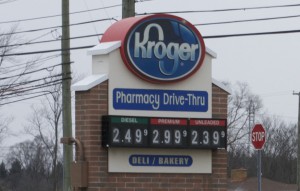
Gas prices went up slightly last month, AAA says, adding its a trend drivers may want to get used to.
The price of gasoline across the U.S. crept up by 1 cent to $2.54 per gallon last month, indicating that the price of gasoline is likely to climb even higher in the months to come according to new report by AAA.
Gas prices increased for 41 states with Florida seeing the largest jump at the pump with a 9-cent increase, AAA said, while the federal Energy Information Administration reported that demand for gasoline decreased only slightly.
“For consumers, the questions is: how high are gas prices going to go in 2018,” said Jeanette Casselano, AAA spokesperson.
“Since 2014, gas prices decreased as much as 20 cents in the first three weeks of the year. This year, gas prices are five cents more than on Jan. 1 of this year, a possible indication that prices in 2018 will likely be more expensive than last year,” Casselano said.
(Fuel economy levels drop in December. Click Here for the story.)
Low fuel prices have been a key factor in boosting sales of trucks and sport utility vehicles since 2014.
The largest increase in prices increase year over year are on the West Coast and in the middle of the country, according to AAA. California with a 39 cents per gallon increase, Michigan with 32 cents, Alaska with 30 cents, Oregon with 28 cents, Hawaii with 28 cents), Montana (+28 cents), Ohio (+27 cents), Illinois (+25 cents) and Tennessee (+25 cents).
The nation’s cheapest market is Texas, where gas is is $2.29 per gallon, followed by Missouri and Alabama at $2.30, Mississippi at $2.31, South Carolina at $2.32, Arkansas at $2.32, Arizona at $2.34, New Mexico at $2.35, Oklahoma at $2.35 and Tennessee at $2.36.
(Click Here for more about gas prices.)
At the close of Friday’s formal trading session on the NYMEX, WTI dropped 58 cents to settle at $63.37. Oil prices slid after EIA’s latest petroleum report underscored that domestic crude production in the U.S. continues to grow. However, the prospect of more expensive crude oil trading regularly at $60 per barrel has helped fuel the rally in the stock market.
On the week, U.S. crude production increased by 258,000 barrels per day (b/d) to 9.750 million b/d. Market observers are looking for indications that growth in the global crude market has slowed, but the U.S. has bucked that trend.
U.S. producers are seizing the higher petroleum prices to grow global market share – as evidenced by crude exports growing to 1.25 million b/d last week. That figure is up from the rate last year at this time, which stood at 704,000 b/d. This growth potentially stalls efforts by OPEC and major crude producers to rebalance the market (by cutting production through the end of 2018, AAA noted.
(To see more about why premium gas is overrated, Click Here.)
AAA also market observers are looking for indications that the crude market may tighten in the coming months were glad to see the number of active oil rigs in the U.S. declined by five last week. The total number of rigs now stands at 747.

Good ‘ol Illinois, can always count on massive potholed roads and fuel price increases